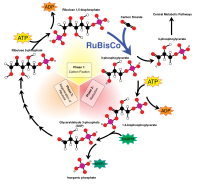
Photo from wikipedia
Transpiration cooling applied to modern ceramic matrix composite materials is an interesting concept for thermal protection of future aerospace applications. Therefore, reliable and accurate numerical tools for the simulation of… Click to show full abstract
Transpiration cooling applied to modern ceramic matrix composite materials is an interesting concept for thermal protection of future aerospace applications. Therefore, reliable and accurate numerical tools for the simulation of transpiration cooling processes in complex flow situations and for complex porous geometries are needed. In this study, we present a fully coupled OpenFOAM solver and discuss the choice of suitable interface conditions as well as the coupling of numerical domains at the transpired surface. Additionally, a modified turbulence boundary condition for transpiration through low-porosity materials is proposed. The numerical solver is then applied to validation test cases with a flat and a double-wedge porous sample under blowing ratios up to $$F_{\text{Air}} = 0.75\%$$ F Air = 0.75 % . The corresponding experiments with Carbon/Carbon samples were performed at the ITLR Hot Gas Facility at supersonic steady-state conditions, i.e. $${\text{Ma}} = 2.5$$ Ma = 2.5 and $$T_{t} = 500\;{\text{K}}$$ T t = 500 K . The simulation results are in good overall agreement with the experimental data for both test cases while capturing the influences of blowing ratio, as well as variations of the external flow field and in the heat flux distribution. Temperature predictions for the sample surface, within the porous wall, and in the downstream wake region show a good conformity to measurements, whereas deviations are observed in the direct wake. Based on the complementary insights provided by the numerical results, aspects such as the coolant through-flow behaviour as well as the sample’s internal temperature distribution and heat conduction are analysed.
Journal Title: CEAS Space Journal
Year Published: 2019
Link to full text (if available)
Share on Social Media: Sign Up to like & get
recommendations!